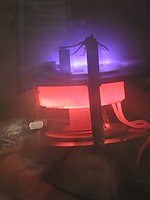
Photo from wikipedia
An experimental and theoretical investigation on microwave plasma-based synthesis of free-standing N-graphene, i.e., nitrogen-doped graphene, was further extended using ethanol and nitrogen gas as precursors. The in situ assembly of… Click to show full abstract
An experimental and theoretical investigation on microwave plasma-based synthesis of free-standing N-graphene, i.e., nitrogen-doped graphene, was further extended using ethanol and nitrogen gas as precursors. The in situ assembly of N-graphene is a single-step method, based on the introduction of N-containing precursor together with carbon precursor in the reactive microwave plasma environment at atmospheric pressure conditions. A previously developed theoretical model was updated to account for the new reactor geometry and the nitrogen precursor employed. The theoretical predictions of the model are in good agreement with all experimental data and assist in deeper understanding of the complicated physical and chemical process in microwave plasma. Optical Emission Spectroscopy was used to detect the emission of plasma-generated ‘‘building units’’ and to determine the gas temperature. The outlet gas was analyzed by Fourier-Transform Infrared Spectroscopy to detect the generated gaseous by-products. The synthesized N-graphene was characterized by Scanning Electron Microscopy, Raman, and X-ray photoelectron spectroscopies.
Journal Title: Materials
Year Published: 2020
Link to full text (if available)
Share on Social Media: Sign Up to like & get
recommendations!